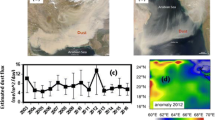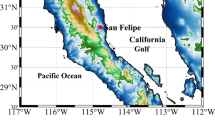Abstract
The events of the dust aerosol transport to the water and coastal areas of the Caspian Sea during 2008–2010 are analyzed. This aerosol type is shown to be an additional source of biogenic elements in the surface layer of the sea. The comparative analysis of the optical characteristics of the northern, middle, and southern parts of the Caspian Sea, which significantly differ in hydrometeorological conditions and, hence, in the contribution of various factors which determine the possibility of anomalous cyanobacterial blooming, has been carried out. The effect of dust aerosol on the bloom of cyanobacteria is maximal in the southern part of the region under study. The results of the study of algal bloom anomalies in the Caspian Sea region are presented.




Similar content being viewed by others
REFERENCES
E. M. Emel’yanov and L. V. Kol’, “Transfer of wind-borne dust and its role in the sedimentogenesis in the Atlantic Ocean,” Litolog. Poleznye iskopaemye, No. 2, 3–15 (1979).
A. P. Lisitzin, “Arid sedimentation in the oceans and atmospheric particulate matter,” Rus. Geol. Geophys. 52 (10), 1398–1439 (2011).
A. P. Lisitsyn, World Ocean. Vol. II. Ocean Physics, Chemistry, and Biology. Sedimentation in Ocean and Interaction between Earth’s Geospheres (Nauchny mir, 2014) [in Russian].
A. P. Lisitsyn, ”A marginal filter of the oceans,” Okeanologiya 34 (5), 735–747 (1994).
A. Avila and J. Penuelas, “Increasing frequency of Saharan rains over northeastern Spain and its ecological consequences,” Sci. Total Environ. 228 (2-3), 153–156 (1999).
C. Darwin, geological observations on the volcanic islands visited during the voyage of H. M. S. Beagle, together with some brief notices on the geology of Australia and the Cape of Good Hope; being the second part of the Geology of the Voyage of the Beagle, under the command of Capt. Fitzroy, R.N., during the years 1832 to 1836,” Quat. J. Geol. Soc. 1 (1), 556–558 (1845).
C. Darwin, Geological Observations on the Volcanic Islands, Visited During the Voyage of HMS Beagle: Together with Some Brief Notices on the Geology of Australia and the Cape of Good Hope (Cambridge University Press, Cambridge, 2011).
C. Guo, X. Xia, P. Pitta, B. Herut, E. Rahav, I. Berman-Frank, A. Giannakourou, A. Tsiola, T. M. Tsagaraki, and H. Liu, “Shifts in microbial community structure and activity in the ultra-oligotrophic eastern Mediterranean Sea driven by the deposition of Saharan Dust and European aerosols,” Front. Mar. Sci. 3, 170 (2016). https://doi.org/10.3389/fmars.2016.00170
R. Gallisai, PhD Thesis (Universitat Politecnica de Catalunya, Barcelona, 2016).
E. Pulido-Villena, T. Wagener, and C. Guieu, “Bacterial response to dust pulses in the western Mediterranean: Implications for carbon cycling in the oligotrophic ocean,” Global Biogeochem. Cycl. 22 (1) (2008). https://doi.org/10.1029/2007GB003091
E. Marañén, A. Fernández, B. Mourino-Carballido, S. Martínez-García, E. Teira, P. Cermeno, P. Chouciño, S. Martínez-Rodríguez, E. Teira, E. Fernández, A. Calvo-Díaz, Anxelu G. Xosé, Bode A. Morán, E. Moreno-Ostos, M. M. Varela, M. Patey, and E. P. Achterber, “Degree of oligotrophy controls the response of microbial plankton to Saharan Dust,” Limnol. Oceanog. 55 (6), 2339–2352 (2010).
T. Yli-Tuomi, L. Venditte, P. K. Hopke, M. S. Basunia, S. Landsberger, Y. Viisanen, and J. Paatero, “Composition of the Finnish Arctic aerosol: Collection and analysis of historic filter samples,” Atmos. Environ. 37 (17), 2355–2364 (2003).
A. A. Vinogradova, “Anthropogenic pollutants in the Russian Arctic atmosphere: Sources and sinks in spring and summer,” Atmos. Environ. 34 (29-30), 5151–5160 (2000).
V. P. Shevchenko, A. P. Lisitsyn, A. A. Vinogradova, K. P. Kutsenogii, V. V. Smirnov, and R. Shtain, “Arctic aerosols and their environmental effect,” in Abstract of the Workshop “Siberian Aerosols” (Publishing House of IAO SB RAS, Tomsk, 2006), p. 148–184 [in Russian].
O. B. Popovicheva, A. P. Makshtas, V. V. Movchan, N. M. Persiantseva, M. A. Timofeev, and N. M. Sitnikov, “Aerosol component of the near-water air layer from observations in “Sever-2015” expedition,” Problemy Arktiki Antarktiki, No. 4, 57–65 (2017).
V. A. Krikun, Candidate’s Dissertation in Mathematics and Physics (Vladivostok, 2008).
M. V. Bolgov, G. F. Krasnozhon, and A. A. Lyubushin, Caspian Sea: Extreme Geological Events (Nauka, Moscow, 2007) [in Russian].
B. N. Holben, T. F. Eck, I. Slutsker, D. Tanre, J. P. Buts, A. Setzer, F. Vermote, J. A. Reagan, Y. J. Kaufman, T. Nakajama, F. Lavenu, I. Jankoviak, and A. Smirnov, “AERONET—a federated instrument network and data archive for aerosol characterization,” Remote Sens. Environ., No. 66, 1–16 (1998).
http://ready.arl.noaa.gov/HYSPLIT.php. Cited May 7, 2021.
J. D. Klett, “Stable analytical inversion solution for processing lidar returns,” Appl. Opt. 20, 211–220 (1981).
A. Ansmann and D. Muller, “Lidar and atmospheric aerosol particles,” in Lidar (Springer, New York, 2005), p. 105–141.
D. Muller, A. Ansmann, I. Mattis, M. Tesche, U. Wandinger, D. Althausen, and G. Pisani, “Aerosol-type-dependent lidar ratios observed with Raman lidar,” J. Geophys. Res. 112, D16202 (2007).
A. H. Omar, D. M. Winker, M. A. Vaughan, Y. Hu, C. R. Trepte, R. A. Ferrare, K. Lee, C. A. Hostetler, C. Kittaka, R. R. Rogers, R. E. Kuehn, and Z. Liu, “The CALIPSO automated aerosol classification and lidar ratio selection algorithm,” J. Atmos. Ocean. Technol. 26, 1994–2014 (2009). https://doi.org/10.1175/2009JTECHA1231.1
V. V. Suslin, V. Kh. Slabakova, D. V. Kalinskaya, S. F. Pryakhina, and N. I. Golovko, “Optical features of the Black Sea aerosol and the sea water upper layer based on in situ and satellite measurements,” Phys. Oceanogr., No. 1, p. 20–32 (2016).
S. A. Lisenko, “A fast algorithm for retrieving maps of atmospheric pollution by fine particulate matter from multispectral satellite images,” Atmos. Ocean. Opt. 31 (1), 60–71 (2018).
V. V. Belov, M. V. Tarasenkov, M. V. Engel’, Yu. V. Gridnev, A. V. Zimovaya, E. S. Poznakharev, V. N. Abramochkin, A. V. Fedosov, and A. N. Kudryavtsev, “Atmospheric correction of satellite images of the Earth’s surface in the optical wavelength range. Optical communication based on scattered radiation,” Atmos. Ocean. Opt. 33 (1), 80–84 (2020).
A. A. Aleskerova, A. A. Kubryakov, S. V. Stanichny, P. N. Lishaev, and A. I. Mizyuk, “Cyanobacteria bloom in the Azov Sea according to Landsat data,” Izv., Atmos. Ocean. Phys. 55 (9), 1416–1426 (2019).
D. V. Kalinskaya and A. A. Aleskerova, “Abnormal optical parameters of the coastal waters in the western Black Sea in spring-summer 2020,” in Abstr. of the XXVII Intern. Symp. “Atmospheric and Ocean Optics. Atmospheric Physics” (Publishing House of IAO SB RAS, Tomsk, 2021), p. 51 [in Russian].
A. V. Varenik and D. V. Kalinskaya, “The effect of dust transport on the concentration of chlorophyll-a in the surface layer of the Black Sea,” Appl. Sci. 11, 4692 (2021).
Funding
This work was supported by the Russian Foundation for Basic Research (grant no. 20-35-70 034—determination of cyanobacteria bloom, and no. 20-54-56 053—processing of satellite images on the presence of cyanobacteria blooms in the southern part of the Caspian Sea) and by the Ministry of Science and Higher Education of the Russian Federation (state assignment no. 0555-2021-0006—processing of satellite images for the presence of dust aerosol, and nos. 0827-2021-0002 and 0555-2021-0003—monitoring with the use of remote sensing data).
Author information
Authors and Affiliations
Corresponding author
Ethics declarations
The authors declare that they have no conflicts of interest.
Rights and permissions
About this article
Cite this article
Kalinskaya, D.V., Medvedeva, A.V. & Aleskerova, A.A. The Influence of Dust Transport on the Intensity of Cyanobacterial Bloom in the Caspian Sea. Atmos Ocean Opt 34, 611–616 (2021). https://doi.org/10.1134/S1024856021060154
Received:
Revised:
Accepted:
Published:
Issue Date:
DOI: https://doi.org/10.1134/S1024856021060154




